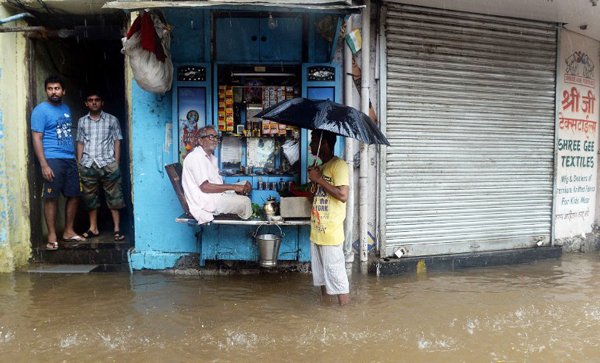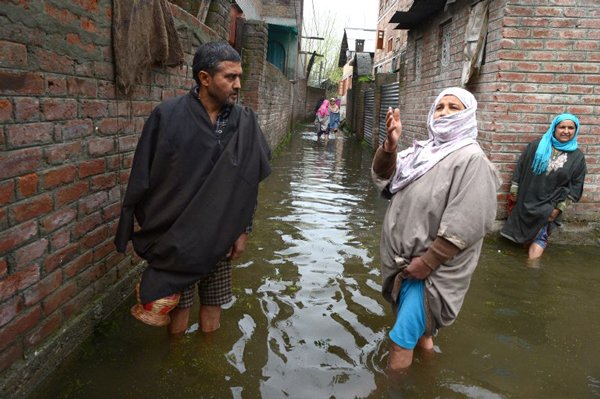Originally published on catchnews | Reported by Nihar Gokhale @nihargokhale | Image Courtesy: thehindubusinessline bushywood
In the past few years, we have seen way too many images of houses sticking out of muddy waters like islands, of people marooned on rooftops of flooded houses, of boats where buses ought to be.
Chennai is the newest backdrop of such pictures, adding to an ever expanding list that includes Jaisalmer, Mumbai, Uttarakhand, Kashmir, Assam. Why?
Our governments would have us believe that it’s all nature’s fury. It certainly isn’t, not entirely.
Nearly all floods that have ravaged various parts of India in recent years can be linked to similar causes, mostly man-made. Every time a flood turns into a disaster, we pledge to address these causes. But we never do.
Why don’t we, and our governments, ever learn the lessons?
What are the common causes of floods?
1) Excessive rainfall
In Chennai, it rained as much in a day as it does over the entire monsoon. The Uttarakhand floods in 2013 were caused by a cloudburst that dumped a lot of water.
2) Climate change
 Photo: Indranil Mukherjee/AFP
Photo: Indranil Mukherjee/AFP
According to this study, heavy rainfall has become more frequent in the past 50-60 years, while instances of moderate rainfall have dipped.
This is what climate scientists have been warning all along: with global warming, weather events like excessive rainfall will become harsher and more frequent. It will also cause rainfall to be concentrated rather than spread out over the season – exactly what happened in Chennai.
3) Dams and reservoirs
When dams and reservoirs are filled up beyond capacity due to excessive rainfall, they run the risk of breaking. To avoid this, water is released which ends up flooding downstream areas.
This is what happened in Chennai when upstream reservoirs on the Adyar river released their stored water.
4) Irrigation canals
Irrigation canals worsen floods in three ways.
They block the natural waterways that lead to rivers or the sea. So when there is too much rainfall, it has nowhere to drain out to.
Since canals are usually embankments, they act like mini dams. Excess water causes breach in the embankments, and flooding. Coastal marshes and mangroves act as natural sinks. Mumbai, Chennai ‘reclaimed’ them for development. They carry excess rainfall from one region and dump it in another, causing flooding. This is a major problem in places like Jaisalmer, where the ground cannot absorb much water. This also happened in Gujarat recently when an overflowing Narmada flooded the Sabarmati river near Ahmedabad.
5) Encroachment
Encroaching a river’s floodplain is an invitation to floods. Floodplains are vast areas along rivers that carry excess water during rainy seasons. Since this area is dry for most of the year, it’s built over. As a result, the river is essentially squeezed in.
This “causes” floods because what is otherwise a natural expansion of the river now submerges buildings. This was the case with the Jhelum in Kashmir, the Alaknanda in Uttarakhand and the Brahmaputra in Assam.
In coastal areas, rivers, lakes, marshes and mangroves act as natural sinks, either absorbing water or leading it to the sea. But they are also easy to “reclaim” and build upon as is the case in Chennai and Mumbai.
6) Concrete overuse
First we made roads that couldn’t absorb water, then we laid concrete on roadsides. Open spaces in buildings are also usually covered in concrete. There is almost no harvesting of rainwater on roofs. Where will all the water go?
What are the common solutions?
How long can we get away with blaming the gods for every disaster? Floods occur when excess rainfall combines with a host of other factors that we have ourselves created. Here are some ways we can possibly fix our mistakes.
1) Protect natural drainage systems
India’s urban planners often don’t take water into account. In fact, water systems are blatantly destroyed.
In Chennai, for example, the local train network was expanded by erecting elevated tracks on the 25-metre wide Buckingham canal. This cut the canal’s width to 10 metres and, thereby, greatly diminished its capacity to carry water into the Bay of Bengal.
3 states, same story: how encroachments on Jhelum, Alaknanda, Brahmaputra banks caused floods.
Again in Chennai, universities and IT parks were set up on wetlands and lake beds, where excess water would make its way as a natural course. This could have been planned better.
2) Set up warning systems
 Photo: Tauseef Mustafa/AFP
Photo: Tauseef Mustafa/AFP
When warning systems exist, why not put them to use? In Chennai, the Anna University is said to have developed an early warning system, but it has never actually been used. In Kashmir, there were no flood warning systems at all.
3) Climate-sensitive planning
The effects of climate change are becoming more and more pronounced. It makes sense then to not wait for a disaster to factor in climate change in our “development activities”.
This includes planning in agriculture, energy infrastructure, water supply and, of course, urban infrastructure, according to Sunita Narain, director general of the Centre for Science and Environment.
4) Smarter management of dams
Since dams increase the risk of flooding, they could be built keeping flood control in mind – or not built at all. The risk multiplies when several dams are built on one river. Cumulative impact assessments explain the impact of dams but they are hardly ever carried out.
Read more at Catchnews.com


 Photo: Indranil Mukherjee/AFP
Photo: Indranil Mukherjee/AFP Photo: Tauseef Mustafa/AFP
Photo: Tauseef Mustafa/AFP







